Shadows are the essence of cinema. After attending the screening of the Lumière brothers’ films at a Russian fair in July 1896, the writer Maxim Gorky wrote: “Last night I was in the kingdom of shadows.” He was right: when the light in the projector hits the unexposed, dark parts of the frame in the celluloid film strip it produces dark light effects, or shadows, on the screen. The prototypes of screen shadows are the shadows we experience in our daily lives, projected on a wall or the pavement. Our shadow is real but at the same time strangely elusive: we cannot touch or feel it, it may be on the ground in front of us but we cannot jump over it or shake it off, and if it is behind us we cannot run away from it. In the cinema, a cast shadow can be perceived as an independent dark shape and an actual part of that surface. Sometimes, the shadow in a film has a substance and life of its own, independent of its owner.
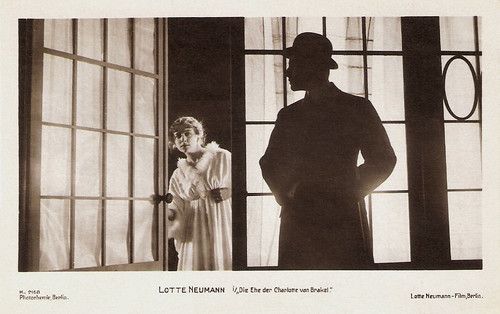
German postcard by Photochemie, no. K. 2168. Photo: Lotte Neumann-Film, Berlin. Lotte Neumann in Die Ehe der Charlotte von Brakel/The Marriage of Charlotte von Brakel (Paul von Woringen, 1918).

German collectors card by Ross Verlag in the series Vom Werden Deutscher Filmkunst - Der Stumme Film, no. 134. Photo: Ufa. Max Schreck as Nosferatu in the first German horror film, Nosferatu (Friedrich Wilhelm Murnau, 1922). In this silent horror film, the vampire Nosferatu can only exist in the dark. He approaches his victim’s bedroom in the form of a disembodied shadow in profile—its hunched, crooked-nosed and clawed-fingered silhouette capturing the distorted, hybrid, human-animal essence of its owner.
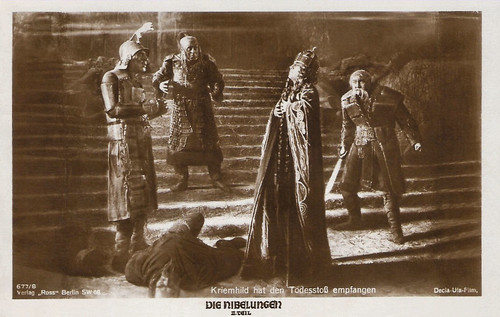
German postcard by Ross Verlag, Berlin, no. 677/8, 1919-1924. Photo: Decla-Ufa-Film. Publicity still for Die Nibelungen 2: Kriemhilds Rache/Die Nibelungen: Kriemhild's Revenge (Fritz Lang, 1924). Kriemhild (Margarete Schön) has gotten the deathblow. In the back, king Hetzel (Rudolf Klein-Rogge) looks in astonishment.
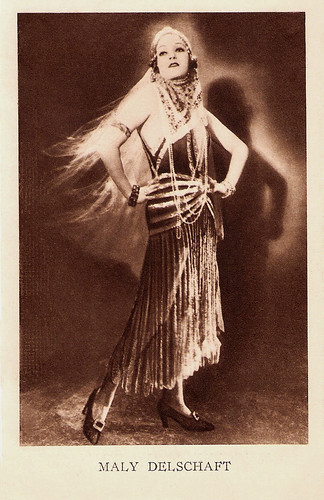
Belgian postcard by NV Cacao en Chocolade Kivou, Vilvoorde. Forgotten diva Maly Delschaft (1898-1995) began her career in the theatre and then became a star in the German silent cinema.
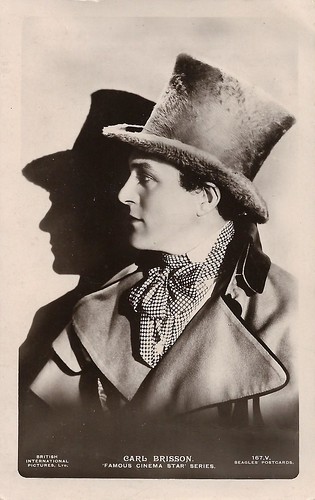
British postcard in the Famous Cinema Star Series by Beagles Postcard, no. 167.V. Photo: British International Pictures. Danish film actor and operetta singer Carl Brisson (1893-1958) appeared in 12 films between 1918 and 1935, including two silent films by Alfred Hitchcock. In the Paramount production Murder at the Vanities (1934), he introduced the popular song Cocktails for Two.

Italian postcard by Ed. A. Traldi, Milano, no. 78. Photo: Pittaluga-Films, Torino. Elena Sangro (1896-1969) was one of the main actresses of the Italian cinema of the 1920s. In spite of the general film crisis then, she made one film after another. She was also one of the first female directors and she had a famous affair with the writer and poet Gabriele D'Annunzio.
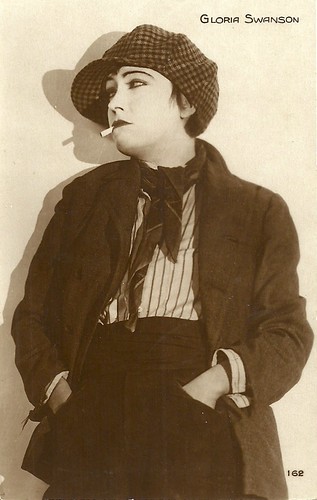
French postcard by Ed. Cinémagazine, no. 162. Gloria Swanson in The Humming Bird (Sidney Olcott, 1924), released in France as Les loups de Montmartre. Gloria Swanson (1899-1983) was one of the biggest Hollywood stars of the silent era. She transformed from a typical Mack Sennett comedienne into a lively, provocative, even predatory, star in films by Cecil B. De Mille. She received Oscar nominations for Sadie Thompson (1928), The Trespasser (1929) and Sunset Blvd. (1950).
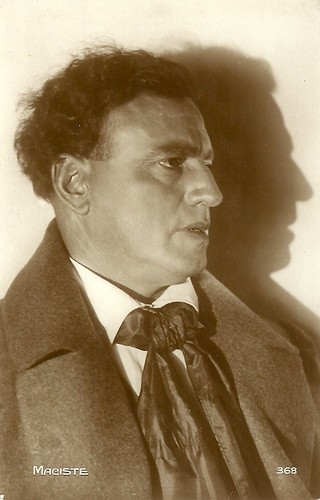
French postcard by Editions Cinémagazine, no. 368. Bartolomeo Pagano aka Maciste in Maciste all'inferno/Maciste in Hell (Guido Brignone, 1926). Italian actor Bartolomeo Pagano's name is forever attached to the character of the strong man Maciste.

Italian postcard by Ed. A. Traldi, Milano. Franz Sala in Maciste all’inferno/Maciste in hell (Guido Brigone, 1926). Franz Sala, aka Francesco Sala (1886-1952) was a prolific actor of the Italian silent cinema, mostly playing the evil antagonist, such as the devil Barbariccia in Maciste all’inferno.
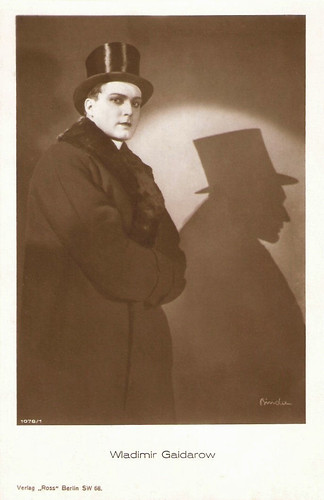
German postcard by Ross Verlag, Berlin, no. 1978/1, 1927-1928. Photo: Alex Binder. Russian actor Vladimir Gajdarov (1893-1976) or Wladimir Gaidarow was a popular star of the European silent cinema.

German postcard by Ross Verlag, no. 6521/2, 1931-1932. Photo: Clarence Sinclair Bull / Metro-Goldwyn-Mayer. Publicity still for Mata Hari (George Fitzmaurice, 1931). Swedish Greta Garbo (1905-1990) was one of the greatest and most glamorous film stars ever produced by the Hollywood studio system. She was part of the Golden Age of the silent cinema of the 1920s and was one of the few actors who made a glorious transition to the talkies. She started her career in the European cinema and would always stay more popular in Europe than in the USA.

German postcard by Ross Verlag, no. 176/12. Photo: Paramount. Elissa Landi in the American epic The Sign of the Cross (Cecil B. DeMille, 1932), based on the original 1895 play by Wilson Barrett. The shadow of the cross is white here.

French postcard by Cinémagazine-Edition, no. 2061. Photo: Paramount. Elissa Landi in The Sign of the Cross (Cecil B. deMille, 1932).

French postcard by EC, no. 90. Photo: Teddy Piaz, Paris. Bach (1882-1953) was a popular French actor, singer and music hall performer. During the 1930s, he was the king of the Comique Troupier (coarse comedy).

British postcard by Raphael Tuck & Sons in the Real Photograph Series, no. 7-8. Photo: Gaumont-British. British actress Madeleine Carroll (1906–1987) was a blonde beauty of ladylike demeanour. The first of Alfred Hitchcock's ‘ice-cool blondes’ was immensely popular in the 1930s and 1940s, and was nicknamed The Queen of British Cinema.

German postcard by Ross Verlag, no. 6574/1, 1931-1932. Photo: Atelier Binder, Berlin. Alfred Abel (1879-1937), best known as the industrial Fredersen in Fritz Lang's Metropolis, played in over 140 silent and sound films between 1913 and 1938.

German postcard by Ross Verlag, no. A 1600/2, 1937-1938. Photo: Metro-Goldwyn-Mayer. Clark Gable in Saratoga (Jack Conway, 1937). In the American romantic comedy Saratoga, Gable plays a bookie at the horse races.
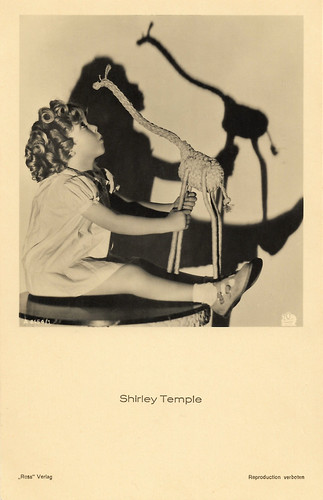
German postcard by Ross Verlag, no. A 2154/1, 1939-1940. Photo: 20th Century Fox. Shirley Temple.
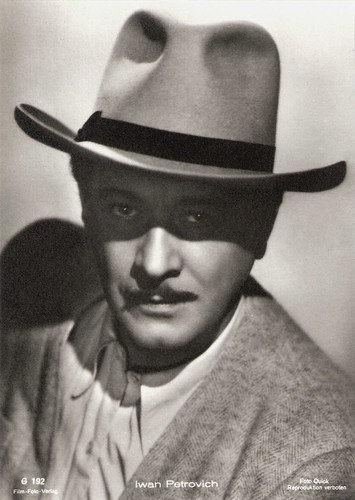
German postcard by Film-Foto-Verlag, no. G 192, 1941-1944. Photo: Quick. Hungarian actor Iván Petrovich (1894-1962) started his career with silent Hungarian films and appeared till his death in nearly 100 European films.

French postcard. Photo: Roger Carlet. Italian-born French actor and singer Yves Montand (1921-1991) represented the ideal of the working class hero with a strong social conscience. The good-looking and talented Montand starred in numerous successful films and his crooner songs, especially those about Paris, became instant classics. But his life was filled with controversy.

Dutch postcard by Uitg. Takken, Utrecht, no. AX 3978. Photo: Paramount. Elvis Presley and Carolyn Jones in King Creole (Michael Curtiz, 1958).
Source: Piotr Sadowski (Semiotix), Wikipedia and IMDb.

German postcard by Photochemie, no. K. 2168. Photo: Lotte Neumann-Film, Berlin. Lotte Neumann in Die Ehe der Charlotte von Brakel/The Marriage of Charlotte von Brakel (Paul von Woringen, 1918).

German collectors card by Ross Verlag in the series Vom Werden Deutscher Filmkunst - Der Stumme Film, no. 134. Photo: Ufa. Max Schreck as Nosferatu in the first German horror film, Nosferatu (Friedrich Wilhelm Murnau, 1922). In this silent horror film, the vampire Nosferatu can only exist in the dark. He approaches his victim’s bedroom in the form of a disembodied shadow in profile—its hunched, crooked-nosed and clawed-fingered silhouette capturing the distorted, hybrid, human-animal essence of its owner.

German postcard by Ross Verlag, Berlin, no. 677/8, 1919-1924. Photo: Decla-Ufa-Film. Publicity still for Die Nibelungen 2: Kriemhilds Rache/Die Nibelungen: Kriemhild's Revenge (Fritz Lang, 1924). Kriemhild (Margarete Schön) has gotten the deathblow. In the back, king Hetzel (Rudolf Klein-Rogge) looks in astonishment.

Belgian postcard by NV Cacao en Chocolade Kivou, Vilvoorde. Forgotten diva Maly Delschaft (1898-1995) began her career in the theatre and then became a star in the German silent cinema.

British postcard in the Famous Cinema Star Series by Beagles Postcard, no. 167.V. Photo: British International Pictures. Danish film actor and operetta singer Carl Brisson (1893-1958) appeared in 12 films between 1918 and 1935, including two silent films by Alfred Hitchcock. In the Paramount production Murder at the Vanities (1934), he introduced the popular song Cocktails for Two.

Italian postcard by Ed. A. Traldi, Milano, no. 78. Photo: Pittaluga-Films, Torino. Elena Sangro (1896-1969) was one of the main actresses of the Italian cinema of the 1920s. In spite of the general film crisis then, she made one film after another. She was also one of the first female directors and she had a famous affair with the writer and poet Gabriele D'Annunzio.

French postcard by Ed. Cinémagazine, no. 162. Gloria Swanson in The Humming Bird (Sidney Olcott, 1924), released in France as Les loups de Montmartre. Gloria Swanson (1899-1983) was one of the biggest Hollywood stars of the silent era. She transformed from a typical Mack Sennett comedienne into a lively, provocative, even predatory, star in films by Cecil B. De Mille. She received Oscar nominations for Sadie Thompson (1928), The Trespasser (1929) and Sunset Blvd. (1950).

French postcard by Editions Cinémagazine, no. 368. Bartolomeo Pagano aka Maciste in Maciste all'inferno/Maciste in Hell (Guido Brignone, 1926). Italian actor Bartolomeo Pagano's name is forever attached to the character of the strong man Maciste.

Italian postcard by Ed. A. Traldi, Milano. Franz Sala in Maciste all’inferno/Maciste in hell (Guido Brigone, 1926). Franz Sala, aka Francesco Sala (1886-1952) was a prolific actor of the Italian silent cinema, mostly playing the evil antagonist, such as the devil Barbariccia in Maciste all’inferno.

German postcard by Ross Verlag, Berlin, no. 1978/1, 1927-1928. Photo: Alex Binder. Russian actor Vladimir Gajdarov (1893-1976) or Wladimir Gaidarow was a popular star of the European silent cinema.

German postcard by Ross Verlag, no. 6521/2, 1931-1932. Photo: Clarence Sinclair Bull / Metro-Goldwyn-Mayer. Publicity still for Mata Hari (George Fitzmaurice, 1931). Swedish Greta Garbo (1905-1990) was one of the greatest and most glamorous film stars ever produced by the Hollywood studio system. She was part of the Golden Age of the silent cinema of the 1920s and was one of the few actors who made a glorious transition to the talkies. She started her career in the European cinema and would always stay more popular in Europe than in the USA.

German postcard by Ross Verlag, no. 176/12. Photo: Paramount. Elissa Landi in the American epic The Sign of the Cross (Cecil B. DeMille, 1932), based on the original 1895 play by Wilson Barrett. The shadow of the cross is white here.

French postcard by Cinémagazine-Edition, no. 2061. Photo: Paramount. Elissa Landi in The Sign of the Cross (Cecil B. deMille, 1932).

French postcard by EC, no. 90. Photo: Teddy Piaz, Paris. Bach (1882-1953) was a popular French actor, singer and music hall performer. During the 1930s, he was the king of the Comique Troupier (coarse comedy).

British postcard by Raphael Tuck & Sons in the Real Photograph Series, no. 7-8. Photo: Gaumont-British. British actress Madeleine Carroll (1906–1987) was a blonde beauty of ladylike demeanour. The first of Alfred Hitchcock's ‘ice-cool blondes’ was immensely popular in the 1930s and 1940s, and was nicknamed The Queen of British Cinema.

German postcard by Ross Verlag, no. 6574/1, 1931-1932. Photo: Atelier Binder, Berlin. Alfred Abel (1879-1937), best known as the industrial Fredersen in Fritz Lang's Metropolis, played in over 140 silent and sound films between 1913 and 1938.

German postcard by Ross Verlag, no. A 1600/2, 1937-1938. Photo: Metro-Goldwyn-Mayer. Clark Gable in Saratoga (Jack Conway, 1937). In the American romantic comedy Saratoga, Gable plays a bookie at the horse races.

German postcard by Ross Verlag, no. A 2154/1, 1939-1940. Photo: 20th Century Fox. Shirley Temple.

German postcard by Film-Foto-Verlag, no. G 192, 1941-1944. Photo: Quick. Hungarian actor Iván Petrovich (1894-1962) started his career with silent Hungarian films and appeared till his death in nearly 100 European films.

French postcard. Photo: Roger Carlet. Italian-born French actor and singer Yves Montand (1921-1991) represented the ideal of the working class hero with a strong social conscience. The good-looking and talented Montand starred in numerous successful films and his crooner songs, especially those about Paris, became instant classics. But his life was filled with controversy.

Dutch postcard by Uitg. Takken, Utrecht, no. AX 3978. Photo: Paramount. Elvis Presley and Carolyn Jones in King Creole (Michael Curtiz, 1958).
Source: Piotr Sadowski (Semiotix), Wikipedia and IMDb.
No comments:
Post a Comment